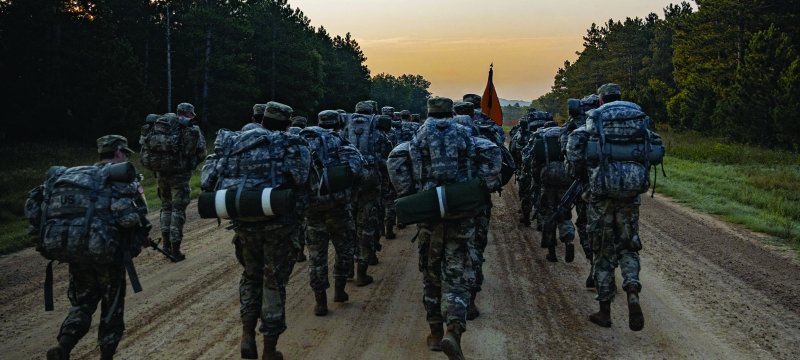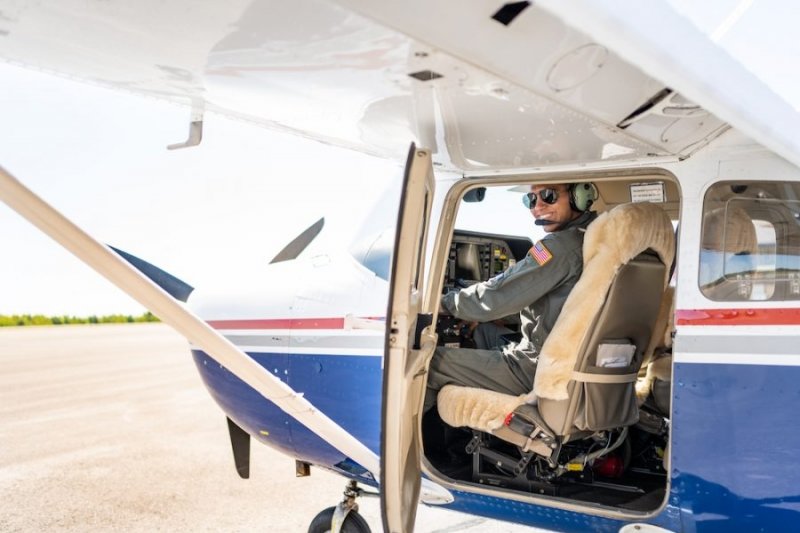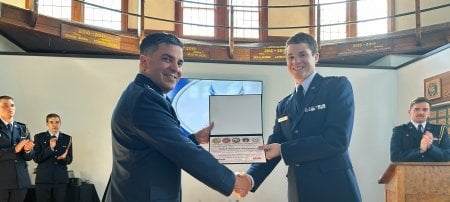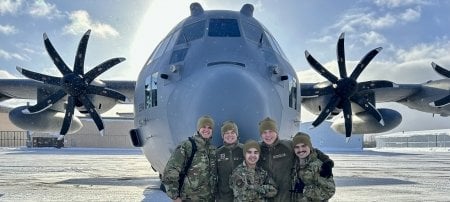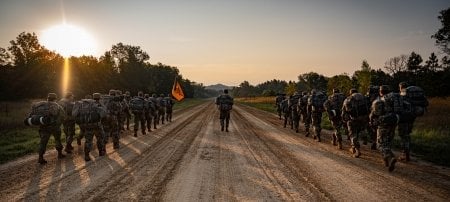Ten-hut! In a salute to Michigan Tech's Arctic Warriors and Guardians of the North past, present, and future, Reserve Officer Training Corps cadets share what makes our ROTC programs national standouts, including a long history forged in patriotism, Husky Pride—and snow.
To civilians, it might be challenging to distinguish between the Arctic Warriors, US Army ROTC 1st Arctic Battalion, and Guardians of the North, US Air Force ROTC Detachment 400, without seeing them in dress uniform. The programs share a building, several traditions, and the common goal of graduating Huskies as commissioned officers. Each program fosters a close community that encourages and celebrates both group and individual accomplishments.
But the programs are as distinct as the branches of the military they serve, guiding cadets toward clearly articulated goals. Field exercises, leadership development, and other training and qualification components vary based on Army and Air Force needs. One example is the US Space Force: Four AFROTC candidates have qualified for the program since its establishment in 2019.

Army ROTC Arctic Warriors

Air Force ROTC Guardians of the North
What remains the same for both ROTC branches is the mutual appreciation for their learning environment on the snowiest campus in the United States. Location has everything to do with why the programs are national standouts.
"What makes the Arctic Warriors different is the Keweenaw and everything that comes with it," says Army ROTC Cadet Daniel Staelgraeve '26. "How many AROTC programs train with snowshoes in six feet of powder? Maybe a couple. But how many of those can do it in their campus's backyard? Our outdoor training opportunities are unique."
Staelgraeve, a mechanical engineering major, says the coursework at Tech also sets these cadets apart from the rest. "In my experience, not a ton of other AROTC cadets are taking technical STEM majors. At Tech, most of us do. There's an emphasis in the battalion on being well-rounded and student-first."
The battalion's commander, Lieutenant Colonel Tide Gile, says Tech's high academic bar meshes well with the Army's expectations for cadets. "I don't sugarcoat things. Nor does the Army," he says. "The course load these students carry is impressive. This is a hard school that produces quality graduates."
AFROTC Cadet Charis Bronson '25 says she chose Tech's program because of its academics and a small-town community that reminded her of home. "I am all the way from Hood River, Oregon, so coming to Tech was a significant decision," she says. "I didn't even know Michigan had an Upper Peninsula until an email showed up in my inbox late in my senior year of high school!"
Bronson opted for Detachment 400 because of its reputation and history—and "simply because it felt right." She calls it one of the best decisions of her life.
"Guardians of the North is the most remote AFROTC detachment in the continental US. We are also consistently one of the highest-performing in the nation," says Bronson. "We have a long history of Upper Peninsula tradition and are one of the oldest detachments in the country."
Army ROTC Cadet Lorelei Weber '26 researched in-state colleges with ROTC programs to help her decide on a school. "This is when I discovered Michigan Tech," she says. "The location had the biggest effect on me. I love that you can drive 15 minutes and be on a beach or out for a hike in the woods."
Weber says the battalion takes full advantage of being surrounded by snow throughout most of spring semester. "We issue snowshoes and conduct rucking PTs (physical trainings). We also conduct a cross-country ski PT once a week throughout the semester. These are some of my favorites!" She also notes that being outdoors isn't all fun and games. Cadets learning to operate as a platoon in cold-weather conditions complete rigorous outdoor lab assignments and prepare for northern warfare competitions.
ROTC Programs Team Up for Service and Recreation

To each their own. Army fires the cannon at Tech's home football games. Air Force's Arctic Blast Drill Team participates in competitive events. Army throws an annual Dining In celebratory annual gathering. Air Force arranges a ceremonial Dining Out. Distinguishing customs aside, battalion and detachment share several traditions.
With approximately 50 cadets in each program—a population that fluctuates depending on the graduation cycle in any given year—there are always opportunities for both camaraderie and friendly competition.
That ability to connect and collaborate distinguishes the Tech programs from others, says AFROTC Detachment Commander Lieutenant Colonel Benjamin Zuniga. "Doing events and activities with another branch of the service is unique," he says. "Because we're considered a medium-sized detachment, we're able to be close; this is an optimal size for the best experience."
In addition to time-honored military traditions including an annual ball, the ROTC programs team up for sponsored community events like the Day of Challenges for area fifth- through 12th-graders. "Being part of Day of Challenges is my favorite tradition because we get to have an impact on younger students and connect with the community," says Weber. "We join together with the local VFW to put on a day full of fun events."
The Arctic Warriors and Guardians of the North also share Color Guard responsibilities, which includes helping to lead the annual Parade of Nations, opening ceremonies for sporting events, and heading up the commencement ceremony procession.

The 9/11 vigil, remembering those who perished in the deadliest terrorist attack on US soil, is a solemn and silent shared tradition. The dawn run that precedes it is anything but—and it's Staelgraeve's favorite.
"The first year, I couldn't help but wonder: 'Why are we screaming and hollering through campus on 9/11 of all days?' However, I have come to appreciate what we do," he says. "On a day that our nation got hit hard, we are loud and proud to say that we are still here, ready to fight back. On top of this, it's an amazing opportunity early in the year to integrate the new freshman cadets and get them loud on campus. If we don't wake people up running near the dorms, that just means we weren't loud enough."
Both ROTC programs also participate in Winter Carnival events, including snow statue construction.

AFROTC Cadet Carinn Tryon '25 says her favorite Guardians of the North tradition is making pancakes for hungry Huskies, served throughout Carni All-Nighter in Fisher Hall. "With some great music and all-you-can-eat pancakes, it's hard to top the atmosphere, especially when I'm doing it with my best friends," she says.
ROTC supports extracurriculars as an essential part of both personal development and achievement, says Staelgraeve, who has two campus jobs, is in four students clubs, and races mountain bikes in the fall in addition to classes and battalion obligations.
"When we get ranked against other cadets in the nation after our third year, the calculation includes your extracurriculars. You gain more points for holding a job or a leadership position in a club," he says.
Among the Nation's Best
- In 2014, Guardians of the North was named the No. 1 Air Force ROTC detachment in the nation.
- In 2015, Michigan Tech was ranked seventh in the nation for our high ROTC participation relative to school population.
- In 2018, Guardians of the North earned top AFROTC detachment in the Northwest.
- In 2023, the 1st Arctic Warrior Battalion was ranked the No.1 Army ROTC program in the Midwest.
High-performance Programs Housed in Tech Traditions
You can't mention Michigan Tech ROTC without noting that the programs are headquartered in the oldest remaining building on campus. The Tudor Revival-style building was designed by the architectural firm Charlton and Kuenzli and built from 1904 to 1906 by prominent regional contractor Herman Gundlach.
The juxtaposition of technology and history taking place in the ROTC Building today is almost as striking as how much cadets cherish it. One of Bronson's most treasured AFROTC traditions revolves around the venerable home base. "My favorite is our annual Christmas party that cadets have in the ROTC Building after we decorate it for the holidays," she says.

Army is headquartered in the basement. Classrooms and offices are on the first floor. Air Force occupies the second floor. Shared lab and physical training space is in the iconic clubhouse gym.
Cadets enjoy showing visitors their surroundings, from the meticulously restored Blue Room to one of the most unique sights you'll see anywhere—the gym, with a suspended wooden track above, framed by a series of windows that pour light into the cavernous space where you can almost hear Huskies of yesteryear shooting hoops or practicing gymnastics landings in preparation for Winter Carnival.
Cadets still work out in the gym—three PT sessions per week, minimum—and conduct labs, drills, other trainings, and special events. But they don't run on the track, and for good reason—the downsloping curve to the narrow railing overlooking the main gym floor 11 feet below is a view both mesmerizing and dizzying.
For more than 40 years, the ROTC Building was the center of Michigan Tech student life. Graduations were held here. The building functioned as a student union, with a bowling alley, handball court, pool tables, boxing arena, and lounge.
As Tech grew and upgraded facilities, adding Sherman Gym and the Memorial Union Building, and later the Student Development Complex, activities shifted elsewhere on campus. Michigan Tech's master plan in the mid-1960s called for the building to be demolished. But in 1978, student Doris Davis—the partner of an ROTC alumnus who had been inside the building and noticed its fine details—nominated the structure for the National Register of Historic Places. It was accepted in 1980.
ROTC alumni continue to take pride in the building, as evidenced by the recent refurbishment of the Blue Room, which was funded by Gary Krasicky '77 and wife Marcia.
"The freshmen probably have no clue why we call it the Blue Room," says Staelgraeve, showing off gleaming natural woodwork, much of it previously hidden under coats of blue paint, in the main-floor classroom overlooking the building's front and east-side lawn.
"Our size and unique location definitely make us stand out, but the quality of our cadets and future officers is what we are most proud of—and what really matters to our nation."
"I'm a construction management major and I geek out over the crown moldings," says Weber.
The Krasickys' most recent contribution also included main entryway restoration, laundry and restroom upgrades, and updates to the Air Force lounge, including a 3D flight simulator where you're apt to see AFROTC Cadet Jonathan Willis '25 at the controls—unless he's off campus, flying in an actual aircraft.
High-flying Huskies Keep Their Eyes on the Prize
Willis, who arrived at Tech as a first-year student with a pilot's license, earned his instrument rating in summer 2023 after two years of work. "The rating allows me to fly in the clouds and under no visibility, just referencing the flight instruments," he explains. A physics major minoring in mathematical sciences and aerospace studies, other highlights of Willis's experiences include being chosen to fly gliders at the US Air Force Academy and recently meeting General Mark Kelly, commander of US Air Force Combat Command, at an AFROTC conference in Washington, DC.
"Being able to talk to one of my role models has only made it more clear that being a fighter pilot is exactly what I want to do," Willis says. "I am still continuing to follow my dream and my sights are still set on the F-22. I've had this dream since I was a sophomore in high school. Since then, my passion has only grown stronger and more focused. It feels like each day in the AFROTC, I get one step closer to achieving my dream."

Willis, slated to graduate in 2025, says his goals have expanded to include attending the highly selective Euro-NATO Joint Jet Pilot Training Program (ENJJPT). "This is the year that truly counts, with a lot of tests that determine how competitive I am for a pilot spot. I've been working very hard," says Willis, who scored the maximum 99 on the TBAS (test of basic aviation skills). "My goal is to be selected for ENJJPT and then fly fighters upon graduation."
Willis says the resources available to him through Guardians of the North—including money for school, equipment that allows cadets to simulate real leadership tests in the field, and a diverse cadre of instructors with a broad range of experience across Air Force careers will help him be a better officer in the future.
"The program always makes sure to tell you the 'why' behind what you're doing," he says. "I first chose to attend Tech because of the great scholarship. After further researching, I learned how great of a school it is for preparing students for STEM careers and cadets for Air Force careers."
Patriotic Huskies Plan a Future of Service
Education funding and knowing they'll have a job right after graduation are typically huge draws for students entering ROTC programs. As Weber notes, the initial motivation to join the program often transforms into something deeper and more selfless as time goes by.
She looks forward to serving.
"I have always had a driving force in my life to help people. The military offers an amazing opportunity to do this. I get to protect the same liberties and freedoms that allowed me to be who I am today," says Weber. "I hope, with my degree, that I can bring value to my military career and then find work in the construction field. I would like to use my degree to make a difference in people's lives by working on hospitals, homes, and other important buildings that help others."
"For many years, I've had a calling to serve," says Bronson. "This country has given me and millions of others opportunities that I am extremely grateful for. There is no other country quite like the USA, and I will do my part to protect it."
The applied ecology and environmental science major is competing for a pilot slot, which would enable her to train after she commissions. "I want to try and fly for Air Force Special Operations," she says. "There is no guarantee I'll end up there. I won't know where or what I will be flying until I complete pilot training. The Air Force is huge, and at the end of the day, they put their people where they need them the most. But I will say that one of the best parts about being in the Air Force is having the choice to pick a dream and go for it."
Once she completes her military career, Bronson says she'd love to put her degree and pilot skills to work for the US Forest Service, NOAA, or another government organization that would enable her to fly for scientific research, weather observation, or firefighting.
Tryon, a mechanical engineering major, is already making her mark as national director of operations for Arnold Air Society, the Air Force's professional honorary service organization open to officer candidates. She oversees 11 regional directors, each of whom supervises five to 12 squadron operations officers. In addition to managing the nationwide volunteer effort, she functions as the central hub of information pertaining to joint national projects.
"A huge chunk of the time, we're just normal college kids. We go out on the weekends, go to parties, and experience typical college life. The difference is that all the while, we are also training so that when we graduate, we can be commissioned into the Army as officers."
"I chose the best of both worlds," says Tryon. Her mom earned her mechanical engineering degree at Tech and her sister attended the Air Force Academy. "I am currently living the dream. In this community, every cadet aspires to achieve the pinnacle: to be commissioned as an Air Force second lieutenant and to embody excellence as an officer in a fulfilling career."
Staelgraeve's short-term goal is to prepare for cadet summer training, a rite of passage that occurs after a cadet's third year. "Doing well helps you rank better in the nation next year, which gives you a better shot at getting the job in the Army you want after graduation," he says.
After he's commissioned, Staelgraeve aims to attend flight school to train as a helicopter pilot. "My long-term dream is to use my Army experience and connections along with my degree to support disaster relief and first aid response efforts for the people of this country."
Commanders, Cadre Build a Support Network
ROTC Commanders Tide Gile and Benjamin Zuniga are both relatively new to Tech, but seasoned in military service. Both work to create a student-first culture in which cadets are encouraged to fully participate in all aspects of life at the University while fulfilling the commitment they've made to their country.
Gile, with 16 years of active duty in the US Army, has worked at the Pentagon helping to write foreign policy.
"I enjoy coaching, teaching, and mentoring—helping to shape leaders of the future. I like seeing the light click on when they get it," he says. He also keeps an eye on how students are doing in their general classes, checking in to see if tutoring or other assistance is required to keep academic performance on track.
Cadets also receive help navigating extra layers of paperwork and logistics. "Contract to commission, the entire team here is built solely for the purpose of supporting the cadets," says Gile.
It's not every Husky, after all, who requires top-secret security clearance for a summer internship.
Air Force ROTC cadets have a similar staff safety net designed to handle important procedural details. In addition to cadre—the military officers mentoring and teaching cadets—both battalion and detachment members rely heavily on their peers. Older cadets tutor younger, whether the help needed is related to courses, drilling, working out safely and effectively, or for general life skills.
Zuniga, whose service in the US Air Force has taken him to more than 70 countries and involved support of multinational air combat operations across the US Central Command theater—along with direct engagements with international partners in Jordan, Qatar, Saudi Arabia, and the United Arab Emirates—knows the impact of the programs' location firsthand. Offline in Africa, when he heard about and accepted the stationing at Tech, he wasn't completely clear on where he was headed in the state of Michigan.
Driving up to Keweenaw from Detroit was an eye-opener.
"The Air Force takes you places you'd probably never have considered otherwise," he says, smiling. "I really like it here."
Michigan Technological University is an R1 public research university founded in 1885 in Houghton, and is home to nearly 7,500 students from more than 60 countries around the world. Consistently ranked among the best universities in the country for return on investment, Michigan's flagship technological university offers more than 120 undergraduate and graduate degree programs in science and technology, engineering, computing, forestry, business, health professions, humanities, mathematics, social sciences, and the arts. The rural campus is situated just miles from Lake Superior in Michigan's Upper Peninsula, offering year-round opportunities for outdoor adventure.
